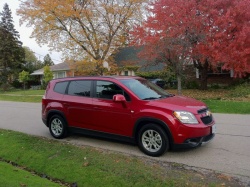 2012 Chevrolet Orlando 2LT. Click image to enlarge |
| More Chevrolet Orlando reviews on Autos.ca
Manufacturer’s web site |
Review and photos by Jonathan Yarkony
Photo Gallery:
2012 Chevrolet Orlando
I like to think of the Orlando as a watershed vehicle for Chevrolet and GM. Sure, the Volt gets all the headlines, and it is a rolling technology showcase, but it’s cars like the Orlando, Sonic and Cruze that are helping GM claw its way back into business. It may not have lithium ion anywhere or plug into a wall outlet, but this is a good vehicle that GM is able to bring to markets where there is a demand for this type of vehicle, and at a price that will get people to take a long hard look at it.
First off, let’s take a moment to bask in some Canadian pride in our taste for efficient vehicles. The Orlando is being imported to Canada (manufactured in Korea) as a competitor to the Mazda5, Kia Rondo and other compact, yet spacious and accommodating family vehicles, but it is not yet being marketed in the States because of there is little interest there in compact six- and seven-seaters.
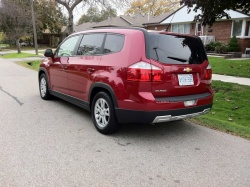 2012 Chevrolet Orlando 2LT. Click image to enlarge |
So what do we get in this latest entrant in the ‘microvan’ segment? A compact family vehicle (it could easily be labeled a crossover, a wagon or a minivan as far as I’m concerned) with seating for seven plus room for a few shopping bags and fuel consumption officially rated at 10.6/6.9 L/100 km city/highway. Observed fuel consumption was within reason, but not quite as optimistic as Natural Resources Canada, at one point clocking 8.1 L/100 km during an extended highway drive and wrapping up a week of mixed highway cruising, highway gridlock, surface roads and parking lots (lots of parking lots) at 10.6 L/100 km.
One aspect of the Orlando that does not stand out from the crowd is its styling. It has a big Chevy bowtie and big headlights, but they are so well suited to the enlarged compact proportions, that everything comes together to look like an ordinary car. The boxy roofline (which allows for stadium seating in the rear) combined with tapered greenhouse and mildly sculpted side panels and fenders keep it from being a boring box. The black plastic fender and sill trim might lend it a bit of rugged appeal, but some commented that it seemed more cheap than rugged… Despite these criticisms, I also believe that this is exactly the kind of design GM needs for this segment: fashionable enough to attract young families, but plain enough to avoid dissent or disenchantment from parents, something that GM paid dearly for with the disastrous Uplander and Nissan with its adventurous Quest.
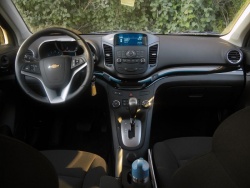 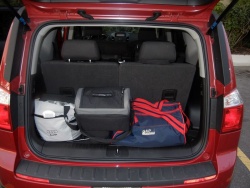 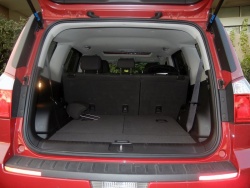 2012 Chevrolet Orlando 2LT. Click image to enlarge |
Moving inside, the styling is a little more imaginative, with a dramatic, curving high-gloss plastic insert splitting the dash and radio controls integrated into a covered hidden compartment that also houses the USB and auxiliary-in ports. However, it was a split decision in our family: while I found it a comfortable and inviting interior, my wife hated the large swath of dash and thought the stereo and HVAC controls seemed cheap compared to some its competitors.
No one took issue with the requisite storage options for the organized or not so organized owners: cupholders, pockets, that hidden cubby hole, and a variety of trunk spaces depending on which seats are needed. Space behind the 3rd row was limited to purses, gym bags or laptops bags, but dropping the back row opened up plenty of space for any typical and large shopping trips. There aren’t many things I would buy that would require both rows of rear seats folded down or be too much for its 1,594 litres of maximum interior volume, which is not quite class best, but sufficient nonetheless.
I doubt many families will be able to sacrifice enough to stick with the base model at $19,995, giving up air conditioning and most power features that most will deem necessary when shopping for a new car. The 1LT, at $22,295, is likely where most people will start, bringing into play A/C, cruise control, power heated mirrors, tilt and telescoping steering wheel, driver armrest and a centre console with a couple of those necessary cupholders and storage areas.
The model we drove, an Orlando 2LT, was well equipped with A/C, Bluetooth connectivity, tinted glass, fog lights, 16-inch alloys, power windows, doors, mirrors and locks, cruise control, satellite radio as part of the $24,835 price. The six-spd automatic transmission ($1450), power sunroof ($1100), power/heated front seats ($880), and rear park assist ($365) quickly drove the price up to $28,730 and destination charge and a/c tax tipped it just over the $30K barrier. This vehicle seems to be a much better value if you can avoid the sunroof and automatic transmission. But if you need the automatic, and want the perks, spring for the LTZ and you get most of the above-mentioned features as part of the $28,495 price, essentially trading the sunroof for 18-inch alloys and some shiny chrome bits and nice interior mood lighting. Leather seats and a navigation system are standalone options, with the nav system ringing in at two grand, versus a Garmin or TomTom for a couple hundred… not the best value, but it’s there if integrated electronics mean that much to you.
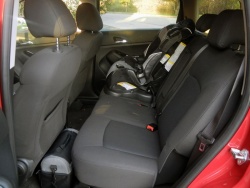 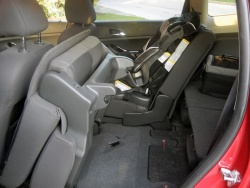 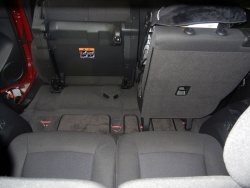 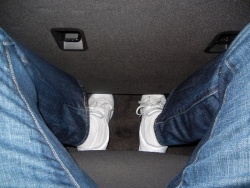 2012 Chevrolet Orlando 2LT. Click image to enlarge |
No matter how you load up the features, all Orlandos come with a 2.4-litre four-cylinder with direct injection, good for 174 horsepower and 171 lb.-ft. of torque. It has no problems getting going with traffic or picking up enough speed for highway merges, and though I wasn’t blown away by the power or refinement, it’s definitely sufficient for this size, and the six-speed auto slips through the gears without drawing attention to itself, which is just about par for the course in this segment. The driving experience is similarly adequate, but still lacking in polish. The Orlando’s composure does its Cruze roots proud taking to corners with a solid, planted reassurance. The steering’s lightweight, which serves it well in crowded parking lots but becomes completely vague and loose through turns. And when cruising along the highway, the lack of on-centre feel led me to wander more than I would like.
After my time in the Orlando, I can’t say that the lack of steering feedback would in any way influence my shopping process in this segment. On the other hand, safety will be a huge concern for families with young children and many others, and the Orlando comes well equipped with standard ABS and 11.8 front and 11.5-inch rear ventilated disc brakes, supplemented by hydraulic brake assist, electronic brake force distribution (controlling braking power at each corner to ensure shortest braking distance), traction control and most importantly, electronic stability control, which will attempt to correct the vehicle’s path through braking if it starts to travel off its intended course.
In concert with the good front and side visibility (the ‘D’ pillar is a challenge), the Orlando comes with the basic tools to avoid trouble that you would expect in this class of vehicle. In the event of a collision, six airbags (front, side and curtain), head restraints and a high-strength steel frame proved themselves in the rigorous European crash testing program (Euro NCAP), earning 5 stars for the Overall rating with a stellar 95 per cent score for Adult protection, though its Child score was a less impressive 79 per cent. Those scores match or beat vehicles like the VW Tiguan, Mazda CX-7, Mercedes-Benz GLK-Class and Volvo XC60, to name a few (of those available in our market) that have undergone the same testing procedure. One last item that can be of crucial significance in the event of a collision is GM’s OnStar with Automatic Crash Response, which opens a line to an OnStar advisor, who can contact emergency services and provide a location for first responders to fix on. GM’s latest adaptation, Injury Severity Prediction, uses vehicle information from the vehicle’s array of electronic sensors to alert paramedics if a collision was likely to have caused serious injury.
The best way to summarize the Orlando is a safe bet. It’s already good enough to hold its own in a competitive small MPV (Multi-Purpose Vehicle) market in Europe, and with little cost to meet Canadian safety regulations, it was worth the effort to bring it to Canada to see if GM could conquest a few thousand more customers from the Kia Rondo, Mazda5, Dodge Journey and other small family vehicles that find plenty of customers in this market.
The prospect of compact-car fuel efficiency (and dynamics), small SUV utility, minivan seating capacity and fresh but safe styling should attract many new shoppers to Chevrolet showrooms, and a quick drive will show consumers that this is an easy vehicle to live with.
|
Pricing: 2012 Chevrolet Orlando 2LT
|














